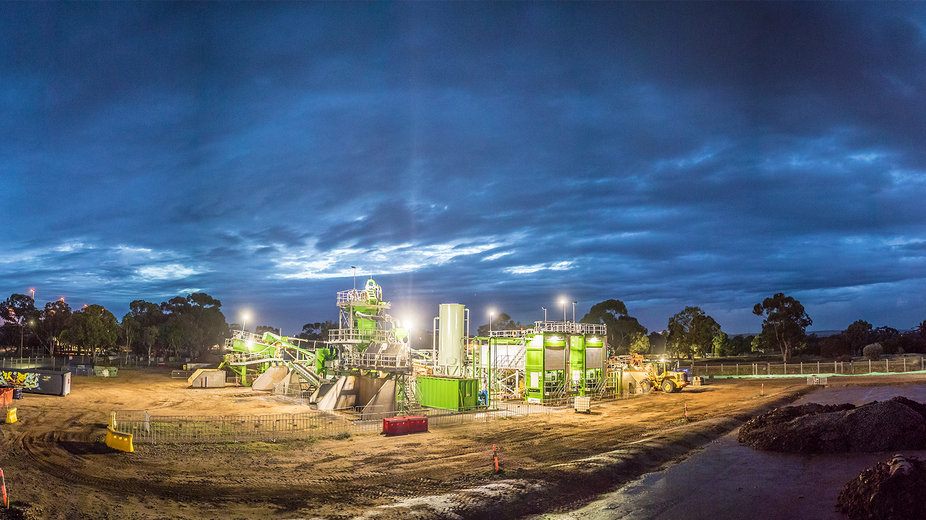A world-first, permanent solution for PFAS soil contamination
SourceZone® a proven success
A world-first full-scale trial to remove PFAS contamination from soil at the Australian Department of Defence (Defence) RAAF Base Edinburgh in South Australia is complete, and the results are impressive.
The trial used SourceZone, a sustainable treatment technology developed for the removal of PFAS contamination from soils. SourceZone is one of the only technologies in the world, proven through this trial, to effectively remove PFAS mass from soil.
Per- and poly-fluoroalkyl substances - PFAS - encompass a family of chemical compounds introduced into common household and industrial products in the 1950s and used extensively in firefighting foams from the 1970s.
This new technology represents an exciting step-change for the remediation industry that has been grappling to find an effective solution to the problem posed by high concentrations of PFAS found in soils at airport, fire training, petrochemical, defence and mine sites.
PFAS removal
SourceZone can effectively remove PFAS from soil at a source site, providing a permanent and complete remediation solution. The trial at RAAF Edinburgh has shown that dependent on soil type up to 99% of PFAS mass can be removed and the waste generated is hyper-concentrated, allowing its safe destruction at licensed thermal facilities.
The SourceZone technology was developed, designed and constructed by Ventia, in conjunction with CleanEarth Technologies Inc, on the back of years of laboratory research.
Through the initial trial process and ongoing treatment, the SourceZone technology has been proven to work at full-scale and on different soil types - from heavy clays through to sand.
Traditional methods of dealing with PFAS chemicals have involved stabilisation (immobilising the contaminants with additives), moving PFAS contaminated soils to licensed landfill sites, or containing them within a bunded, covered area at the source site.
Whilst some of these methods may be cost-effective in the short-term, they are simply deferring complete resolution of the problem to future generations and are not in accordance with the preferred hierarchy for PFAS treatment and remediation options outlined in the Australian Government's PFAS National Environmental Management Plan (NEMP 2.0).
A sustainable solution
The technology's sustainability credentials are high. Treatment of PFAS contaminated soil at the source site using SourceZone has the benefit that the bulk of the cleaned soil can be reinstated at the site, eliminating the financially and environmentally expensive cost of transportation and off-site disposal.
During this trial, approximately 600 trucks were kept off the roads, saving over 300 tonnes of CO2 emissions. SourceZone saved a further 600 tonnes of CO2 emissions by also treating the assumed hazardous/Category A soil on site (approximately 50% of the total soil).
SourceZone generates less than one per cent waste, weight for weight, and the water used in the process is treated and recycled through the plant continuously, meaning no water is discharged off-site.
Carbon dioxide emissions are 75-90% lower than using thermal destruction.
With its light environmental footprint, the ability to move the plant to PFAS hot spots and its permanent removal of contaminants from soil, SourceZone represents an exciting and sustainable solution for PFAS remediation.
A solution for defence, a solution for the planet
The trial of SourceZone was in response to the findings of a three-year investigation into PFAS contamination. This found that, of the 27 potential contamination source areas on the Edinburgh base, 12 represented "a significant source of…contamination, where the environmental sample results exceeded the adopted human health and/or ecological guidance values".
Over the last two years, a close working partnership with the Department of Defence and Ventia culminated in a positive result for both parties. Over 10,000 tonnes of PFAS contaminated soil from RAAF Base Edinburgh, and 1,500 tonnes transported from RAAF Base Williamtown, was successfully treated.
The amount of PFAS removed by SourceZone during this trial was equivalent to approximately 25 years' worth of fire-fighting exercises and represents a significant reduction in PFAS mass at the locations treated.
This trial represented a unique opportunity and great foresight by Defence to work collaboratively with industry to develop a solution for the global PFAS problem. Reducing the PFAS mass in soil reduces the risk of contamination to site personnel, local communities, and the environment.
Not only has this technology turned back the clock on the significant issues associated with historical use of PFAS at Defence bases around the country, it paves the way for other full-scale remediation projects at PFAS contaminated sites around the world.
- SourceZone achieved an average PFAS removal efficiency of 90% for clay soils and 99% for sandy soils
- Approximately 46 kilograms of PFAS mass was removed from soil treated at the site
- 46 kilograms of PFAS mass is equivalent to about 25 years' worth of PFAS contamination from fire-fighting exercises at the site
- Treating a 5ug/L PFAS plume using a water treatment plant would take 58 years to remove 46kg of PFAS mass from the sub-surface soil
25 years of fire-training exercises was estimated using the following calculations. 3M Lightwater, the AFFF product used by Defence that contained the most PFOS, contained about 0.5% PFOS equating to 5g PFOS per L of AFFF. At RAAF Edinburgh fire fighters indicated about 30L of AFFF was used per training exercise and training occurred monthly. Therefore ~30L x 5g/L = 150g of PFOS was used per monthly AFFF event. To date Ventia's plant has removed 46kg of PFOS + PFHxS from the environment equating to 307 monthly fire training events or c.25 years of average fire training exercises.

